Applying to college can feel like climbing a mountain—exciting, scary, and a little scary all at the same time. If you’re hoping to tour Harvard’s halls and enjoy the California sunshine at Stanford, your major is your first stop. I’ve been there, and I know how it feels to look at an application form, wondering where to start. Over the years, I’ve picked up a few tips to make this process more fun and easier. For schools, they get interviews from Harvard, MIT, Stanford, Princeton, and Yale, to see what they’re looking for. Let’s take a look at the Top 10 University Application Tips:
1. Start Early—Timing Is Everything
I can’t stress this enough: don’t wait until the last minute. Starting early gives you breathing room to refine your application and avoid that panicked, all-night essay-writing session (trust me, I’ve been there, and it’s not pretty). Most top universities—like Harvard University (ranked #1 globally by U.S. News & World Report)—have deadlines in early January for regular decisions, but early action or early decision deadlines can creep up as early as November 1st. Take MIT (Massachusetts Institute of Technology). Their early action deadline is November 1st, and they’re known for admitting students who show initiative—like starting their applications months ahead. Planning early lets you research each school’s requirements, gather transcripts, and line up recommenders without sweat.
How to Do It:
- Create a timeline. Mark deadlines for your top schools (e.g., Stanford’s early action is November 1st too).
- Start brainstorming essay ideas in the summer before your senior year.
- Request transcripts and test scores at least a month before they’re due.
Starting early isn’t just about logistics; it shows schools you’re serious. When I applied to college, I began in June and had my essays drafted by August. It made all the difference.
2. Research Your Universities Thoroughly
Not all universities are the same, even among the top dogs. Stanford University, the “best U.S. college,” loves students who vibe with its entrepreneurial spirit—think startups and innovation. Meanwhile, Princeton University (#4 in many rankings) leans hard into undergraduate teaching and research opportunities.
Before you apply, dig into what makes each school tick. Visit their websites, read student blogs, and check out their mission statements. For example, Yale University (#5 in global rankings) emphasizes a liberal arts education and community engagement. Tailoring your application to reflect their values can set you apart.
How to Do It:
- Make a list of your top 5-10 schools and note their unique strengths (e.g., MIT’s focus on STEM, Yale’s residential college system).
- Follow their social media for a peek into campus life.
- Attend virtual info sessions—most schools offer them now.
When I researched my dream school, I found out they valued community service, so I highlighted my volunteer work. It worked like a charm.
3. Craft a Standout Personal Statement
Your statement is your chance to tell your story—and it’s a big deal. Admissions officers at places like Harvard and Stanford read thousands of essays, so yours needs to pop. Forget generic sob stories or bragging; focus on something authentic that shows who you are.
Take Harvard, for instance. Their admissions team looks for “intellectual vitality”—a fancy way of saying they want curious, passionate people. I once read an essay that got someone into Harvard—it was about fixing a broken radio with their grandpa. Simple, but it showed problem-solving and heart.
How to Do It:
- Pick a specific moment or experience that shaped you (e.g., a challenge you overcame, or a passion you discovered).
- Write in your voice—don’t try to sound like a 40-year-old professor.
- Revise, revise, revise. Get feedback from teachers or friends.
Mine was about teaching myself guitar during a tough year. It wasn’t flashy, but it was me. Aim for that.
4. Highlight Your Extracurriculars Strategically
Top schools don’t just want good grades—they want well-rounded humans. MIT loves students who tinker with robots or code apps in their spare time. Princeton, on the other hand, might swoon over someone who’s led a debate team or organized a charity drive.
The trick? Quality over quantity. Admissions officers can spot a “résumé padder” a mile away. Focus on a few activities where you’ve made a real impact. I was in three clubs but led one as president—that’s what I emphasized.
How to Do It:
- List your top 3-5 activities and describe your role (e.g., “Founded a coding club that grew to 20 members”).
- Tie them to your goals—e.g., if you’re applying to Stanford’s engineering program, highlight that robotics project.
- Use numbers to show impact (e.g., “Raised $500 for a local shelter”).
5. Ace Your Standardized Tests (If Required)
Tests like the SAT or ACT used to be non-negotiable, but many schools—like Yale—are now test-optional. Still, a strong score can boost your app, especially at competitive places like MIT, where the middle 50% of admitted students score 1520-1580 on the SAT.
If your schools require or recommend tests, prep smart. I spent two months studying, and my score jumped 200 points. It’s worth it.
How to Do It:
- Check each school’s policy (e.g., Harvard’s test-optional through 2026).
- Use free resources like Khan Academy for SAT prep or ACT’s official guides.
- Take practice tests to build stamina—those things are long!
6. Secure Stellar Recommendation Letters
Your teachers and counselors can vouch for you in ways you can’t. At Stanford, they want letters that reveal your character and work ethic, not just your grades. I asked my math teacher who’d seen me struggle and then soar—she wrote a letter that made me sound like a rockstar.
How to Do It:
- Ask early—give them 6-8 weeks’ notice.
- Choose people who know you well, not just the “cool” teacher.
- Give them a “brag sheet” with your achievements and goals to guide them.
A good letter can tip the scales, so don’t sleep on this.
7. Nail the Supplemental Essays
Most top schools—like Princeton—ask for extra essays beyond the personal statement. These are goldmines for showing fit. Princeton’s prompts often ask about your values or interests, while MIT might want to know how you’ll tackle a global problem.
I wrote a Princeton supplement about a book that changed my perspective—it showed I was their kind of thinker. Make yours specific and personal.
How to Do It:
- Read each prompt carefully and brainstorm unique angles.
- Connect your response to the school’s culture or programs.
- Keep it concise—most are 250-500 words.
8. Show Demonstrated Interest
Some schools track how much you care. Yale doesn’t officially, but others—like Washington University in St. Louis (a top-20 school)—do. Visiting campus, attending webinars, or emailing admissions with smart questions can signal you’re serious.
I emailed an admissions officer at my top choice with a question about their biology program. They remembered me when I got in.
How to Do It:
- Sign up for virtual tours or info sessions.
- Engage on social media—comment on their posts.
- Mention specific programs in your essays (e.g., Stanford’s design school).
9. Double-Check Your Application
Typos or missing documents can sink you. Harvard gets 60,000+ applications yearly—they won’t chase you down for a lost transcript. I once forgot to upload a test score and had to scramble to fix it. Don’t be me.
How to Do It:
- Proofread everything—twice.
- Submit a week early to avoid tech glitches.
- Confirm all materials (transcripts, scores) are received via the portal.
10. Be Yourself—Authenticity Wins
This sounds cheesy, but it’s true. Stanford and MIT don’t want cookie-cutter applicants—they want you. When I applied, I worried I wasn’t “impressive” enough. But my quirks—like my obsession with old sci-fi movies—made me memorable.
How to Do It:
- Share what excites you, even if it’s niche.
- Avoid exaggerating—admissions can smell it.
- Reflect on what makes you, you.

A Peek at Top Schools
Here’s a quick rundown of the Google top 1-5 universities and what they love in applicants:
1. Harvard University (Cambridge, MA)
- What They Want: Leadership, intellectual curiosity, impact.
- Fun Fact: 5% acceptance rate—tough, but dream big!
2. MIT (Cambridge, MA)
- What They Want: Problem-solvers, STEM passion, hands-on projects.
- Fun Fact: 80% of students do research by graduation.
3. Stanford University (Stanford, CA)
- What They Want: Creativity, initiative, interdisciplinary thinkers.
- Fun Fact: Located in Silicon Valley—startup central.
4. Princeton University (Princeton, NJ)
- What They Want: Academic rigor, community focus, independent research.
- Fun Fact: No loans—all aid is granted.
5. Yale University (New Haven, CT)
- What They Want: Diverse perspectives, artsy vibes, global citizens.
- Fun Fact: Famous for its secret societies.
Conclusion
Top 10 University Application Tips, And there you have it—your roadmap to a killer university application! These 10 tips aren’t just steps; they’re your ticket to standing out at places like Harvard or Stanford. It’s not about being perfect; it’s about being you, with a sprinkle of strategy. So, grab that laptop, start early, and pour your heart into it. You’re not just applying to college—you’re chasing your future. Which tip will you tackle first? Let me know, and good luck—you’re going to crush it!
FAQ
What are the red flags on a college application?
Top 10 University Application Tips, Inconsistent grades, plagiarism, generic essays, or missing deadlines raise red flags. Arrogance, lack of effort in activities, or weak recommendations can hurt, too. Colleges like Harvard notice if you don’t show genuine interest or maturity in your application.
What is the #1 factor colleges look for in applicants?
Academic excellence tops the list—think strong GPA and rigorous courses. Schools like MIT prioritize this, but it’s paired with passion and fit. They want students who’ll thrive in their unique environment, not just ace tests.
How do I make my college application stand out?
Top 10 University Application Tips, Showcase your unique story—specific passions or achievements, like leading a project or overcoming challenges. Tailor essays to schools like Stanford, highlight impact in activities, and get glowing recommendations to shine bright.
What looks good on an Ivy League application?
Top 10 University Application Tips, Ivy League schools like Yale love top grades, leadership, and deep extracurricular commitment—think founding a club or winning awards. Authentic essays, intellectual curiosity, and strong teacher support seal the deal.











